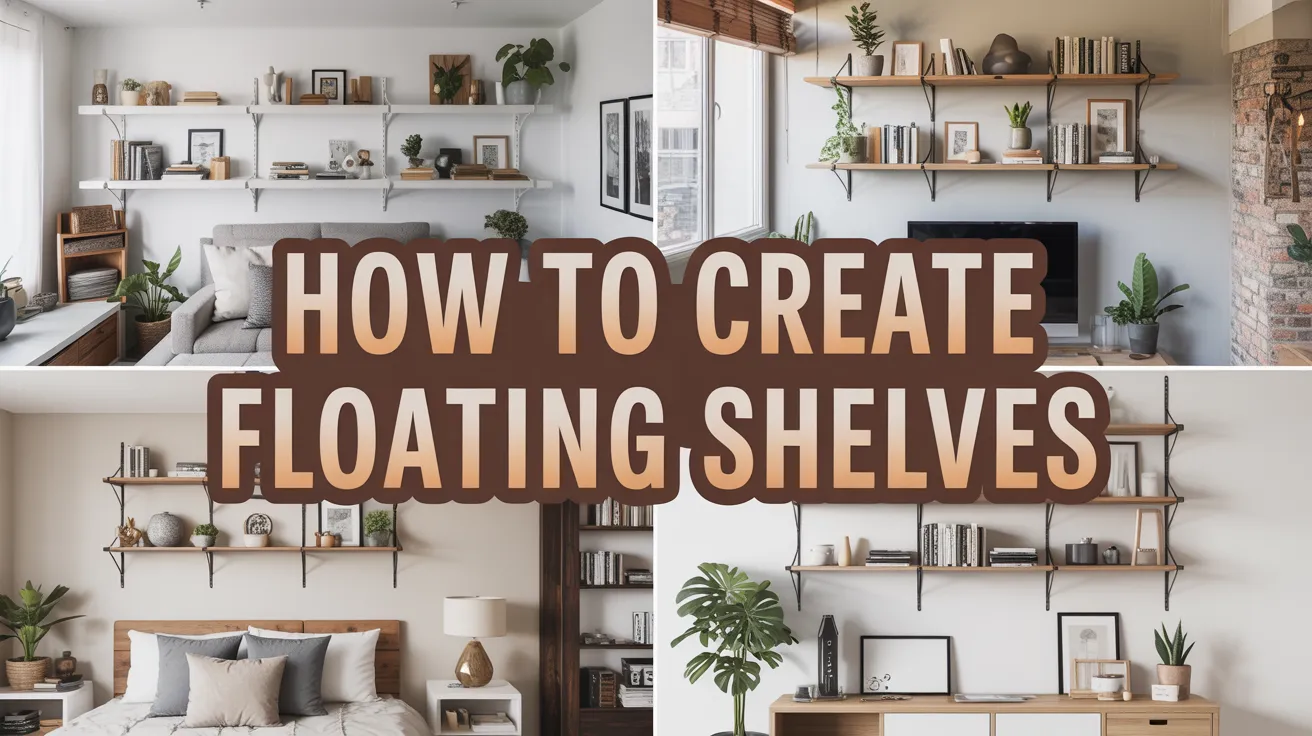How to Create Floating Shelves: Step-by-Step DIY Guide
Floating shelves offer a clean and modern way to add storage or display space without bulky brackets. They appear to “float” on the wall because the support is hidden inside the shelf itself. To create floating shelves, one must secure strong metal rods or dowels into the wall studs and slide the shelves onto these supports, making the brackets invisible.

This method works for wood shelves of different sizes and can be adjusted to fit any space. Using the right tools and materials, someone can build sturdy shelves that hold books, decor, or kitchen items while maintaining a sleek look. With some basic skills, the process of cutting, drilling, and installing is simple and efficient.
Floating shelves are a great choice for anyone looking to maximize wall space with style. They can be made cheaply and customized for any room, making them a practical and attractive solution for storage needs.
Materials and Tools for DIY Floating Shelves

This project requires specific materials and tools to build sturdy and clean-looking floating shelves. Proper wood, screws, anchors, and brackets paired with the right cutting and leveling tools will ensure a secure and polished shelf. Choosing quality supplies and equipment simplifies the process and improves the final result.
Essential Materials for Floating Shelf Projects
A DIY floating shelf project starts with the right materials for strength and appearance. The main components include:
- Wood board: Common sizes are 2″ x 10″, cut to the desired length. The wood type depends on style and shelf load.
- Floating shelf bracket: A hidden bracket designed to support the shelf from the wall.
- Wood screws: Used to attach brackets to the wall and shelf.
- Wood glue: Adds extra hold between parts, though screws provide most stability.
- Wall anchors or drywall anchors: Needed if the shelf can’t be attached directly to studs.
- Optional finish materials: Stain, paint, or polyurethane to protect and enhance the wood.
These materials ensure the shelf holds weight safely and fits the room’s decor.
Key Tools Needed for Construction
Successful assembly relies on having the right tools for cutting, measuring, and mounting:
- Power drill: Drives screws and makes holes for wall anchors.
- Stud finder: Locates wall studs to secure brackets firmly.
- Level: Ensures the shelf is straight during installation.
- Measuring tape: For precise cuts and bracket placement.
- Saw (miter saw or table saw): Cuts the wood board to the exact size.
- Orbital sander or sandpaper: Smooths edges and surfaces before finishing.
- Clamps (optional): Hold wood pieces steady when gluing or sanding.
Using these tools improves accuracy and safety, making the build process smoother.
Choosing the Right Wood and Hardware
Wood choice affects both the look and the shelf’s durability. Pine is affordable and easy to work with but less strong. Oak and walnut offer more strength and grain quality for heavier or high-style shelves.
Selecting the right wall hardware is just as important. If studs are detected, wood screws into studs provide the best support. Without studs, high-quality wall anchors or toggle bolts prevent the shelf from falling. The bracket system must fit the wood thickness and hold weight properly.
Choosing hardwood and reliable mounting hardware creates a floating shelf that looks good and lasts long.
Building and Installing Floating Shelves
Creating floating shelves involves precise measuring, careful assembly, sturdy mounting preparation, and secure attachment. Each step ensures the shelves are strong, level, and safe to use. Attention to detail during cutting, joining, and fixing the shelves to the wall is essential for durability.
Measuring and Cutting Shelf Components
Accurate measurements are the foundation of a solid floating shelf project. First, measure the wall space and decide the shelf length and depth. It is common to use plywood or hardwood planks about 1 to 1.5 inches thick for strength.
After marking the desired dimensions on the wood, use a circular saw or table saw to cut the boards. Cut the shelves to size, along with pieces for the internal support box, which will hide mounting hardware.
Smooth edges by sanding each piece. Use wood filler to fill any gaps or defects before sanding again. Finally, apply wood stain if desired, allowing it to dry completely before assembly.
Assembling the Floating Shelf Box
The floating shelf’s strength comes from its hidden internal box frame, often called a cleat system. This involves cutting strips of wood to form the sides and back of the box.
Begin by assembling the frame with wood screws. The box should be slightly smaller than the shelf surface boards to fit flush when attached. A square and level tool helps keep corners tight and even.
Secure the cleat inside the box to provide a sturdy mounting base. The cleat will later attach to wall studs, so it must be well reinforced.
Sand any edges and surfaces again if needed. Stain the box frame to match or complement the shelf surface.
Preparing the Mounting Structure
Locating wall studs is critical for a safe installation. Use a stud finder to mark stud positions behind the drywall. The cleat must be screwed directly into studs for maximum support.
If studs don’t align well with the shelf length, consider adding vertical supports or using heavy-duty drywall anchors rated for the shelf load.
Attach the cleat or ladder support system horizontally onto the studs first. Confirm it is level using a spirit level before tightening screws fully.
Touch up any exposed wood or wall gaps with paint or stain to blend in with the existing wall and shelf.
Attaching and Securing the Floating Shelf
Once the cleat base is solidly mounted, slide the shelf box over the cleat. It should fit snugly without wobbling.
Secure the shelf to the cleat internally by drilling screws from underneath or behind the box frame to avoid visible fasteners.
Perform a final sanding if needed and apply a protective finish or additional stain coats. Avoid polyurethane finishes if the shelves will store heavy or rough items, as minor scratches are less noticeable.
Now the floating shelf is ready to hold tools, decor, or storage bins, combining strength and a clean, modern look.
Conclusion

Floating shelves offer a practical way to add storage without bulky supports. They create a clean, modern look that fits many room styles. Whether for a kitchen, living room, or office, they maximize space efficiently.
Building floating shelves requires basic tools and careful planning. Measuring accurately and mounting brackets into studs ensures the shelves hold weight safely. Choosing the right wood and finish protects the shelves and matches the room’s decor.
Some key points to remember:
- Use a level to keep shelves straight.
- Select sturdy brackets rated for your shelf size.
- Sand and finish wood for durability and appearance.
The project cost varies based on wood type and tools, with an estimated range from $35 to $265. Using proper hardware for your wall type prevents damage and helps secure the shelves.
With patience and the right steps, anyone with basic DIY skills can create floating shelves that are both functional and stylish. They provide a customizable solution to display items or increase storage while keeping a room’s appearance neat and open.

